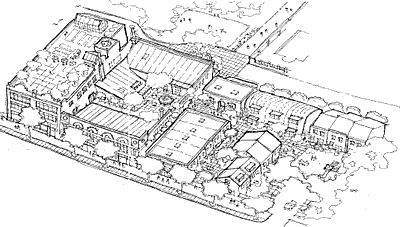| home | our mission | contact us | issue archive |

Dec 2001 / communities :: email this story to a friend

Common Space of a
Different Sort
By Tom BrafordIt is interesting, if not a bit ironic, to be asked to write an article about cohousing for an on-line publication called The Commonspace. Interesting because, at a time when so much seems to separate us, the idea of common space, a space where divergences can come together, is indeed intriguing. Ironic because the provision of "common space," in this case actual physical environs where people can come together on a regular basis, is one of the defining characteristics of cohousing.
So, you might ask, besides the physicality of this kind of common space, how is it different from an on-line chat room? Or, given the physicality, how is it different from gathering at a community center, park, church or café? The answers are manifold. In cohousing, individuals and families typically own and occupy private spaces that are complete with kitchens, bathrooms, bedrooms, etc.; in effect, everything that you would expect in a single-family home. This space, however, tends to be sized down by eliminating things like guest rooms, family rooms, separate dining rooms, sometimes laundry facilities. Instead, many of these features and others, like a kids' playroom, an exercise room, a large kitchen and dining room, workshops, studios, offices, are shared by a group of cooperating neighbors in the common house. This space and the pedestrian streets, central greens and courtyards that make up the common space in these self-contained residential communities are qualitatively different, however, from what we typically think of as both private space on the one hand and public space on the other.
For most people hearing about cohousing for the first time, it is clear (once they understand that you have your own kitchen in cohousing) that the private space is not much different from what we are all used to. When you talk about common space, however, people still wonder how it is different from publicly owned space like a community center or a park or privately owned public space like a church or café, or a condominium clubhouse, for that matter. The difference is in how you use and manage the space. In cohousing, you use the common house and green areas as an extension of your individual home or yards, and you jointly manage the community with your cohousing neighbors. You typically share meals together with your neighbors in the common house three or four times a week. You often hang out in the common house or at gathering nodes along the pedestrian street running through the community. You can work out in the exercise room, fold clothes in the shared laundry, and work in the community garden, shops or studios with your neighbors.
The real acid test, however, is: would you feel comfortable letting your three-year-old spend time in these spaces unaccompanied? In cohousing, with a couple of obvious exceptions like the workshop or crafts room that might contain dangerous equipment, the answer is yes. The common space in cohousing is so accountable in the way it is designed, and you come to know your neighbors so well, even before you move in, that, yes, in most cases you would feel comfortable sending your three-year-old over to the common house or out to the common playground to play with their friends.

Unfortunately, for most of us these days, sending our young children of any age to the local park or community center unaccompanied is no longer an option. Even before September 11th, our innocence was eroding. Now, more than ever, we need community. We need common space where we can come together to heal our psyche and heal our society. Creating common space on the Internet and in cohousing communities are two ways in which we can heal ourselves enough, to create enough commonness of space in our hearts, to make our parks and community centers, and even our streets and alleys, safe enough again for unaccompanied three-year-olds. Until then, it is incumbent on all of us to look out for as well as love our neighbors, especially our neighbors' kids. In cohousing, it goes without saying that it takes a village to raise a child, and a village is not a village without common space.
The cohousing movement got started in Denmark almost 35 years ago. It now accounts for 10% of all new housing there and has spread through Western Europe, the U.S., Canada, and Australia and is arriving in Japan. It is growing twice as fast in the U.S. as it did in Denmark, with 60 communities up and running and another 100 in various stages of planning and development.
From Berkeley to Boston and Ann Arbor to Austin, cohousing is coming to a neighborhood near you. In St. Louis, Culver Way Cohousing is under way in the Central West End. Phase I is almost sold out, so don't put it off if you want to be part of this dynamic community. A long established University City group is zeroing in on a site, a residential community with religious affiliation in the Old North St. Louis neighborhood is reorganizing as cohousing, and a group is in the early stages of group formation and planning in Soulard.
The Culver Way project is being developed by Irresistible Community Builders, LLC; we offer a full range of services to form and manage sustainable communities. To learn more about them or Culver Way Cohousing, contact us at 314-534-4780 or email us at braford@aol.com.
Tom Braford is a builder and developer who lives in St. Louis.
Church and State | Games | Expatriates | Communities | From the Source
It's All Happening | Young Minds | The Ordinary Eye | Elsewhere
Sights and Sounds | Media Shoegaze | A Day's Work | From the Editor
© 2001 The Commonspace
